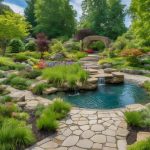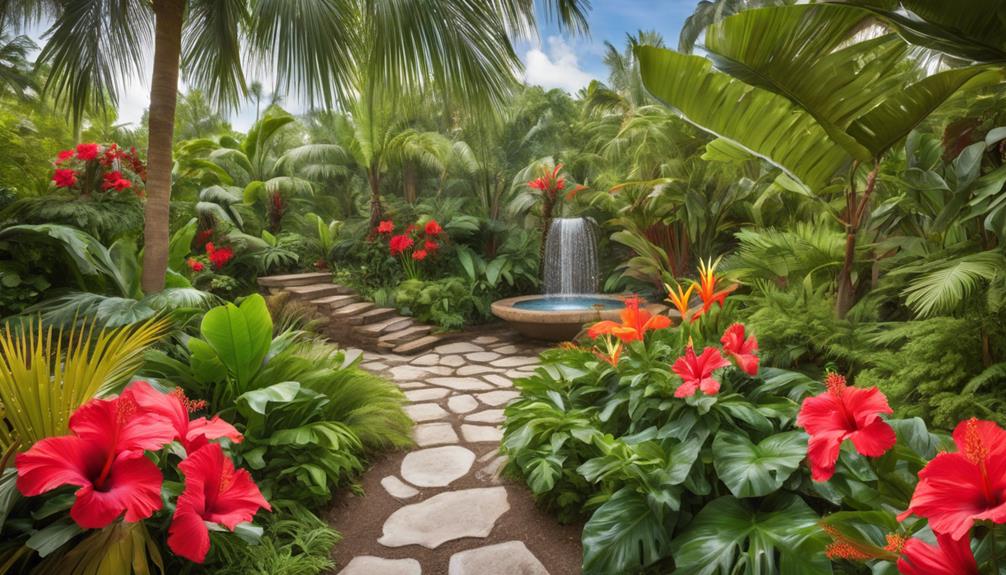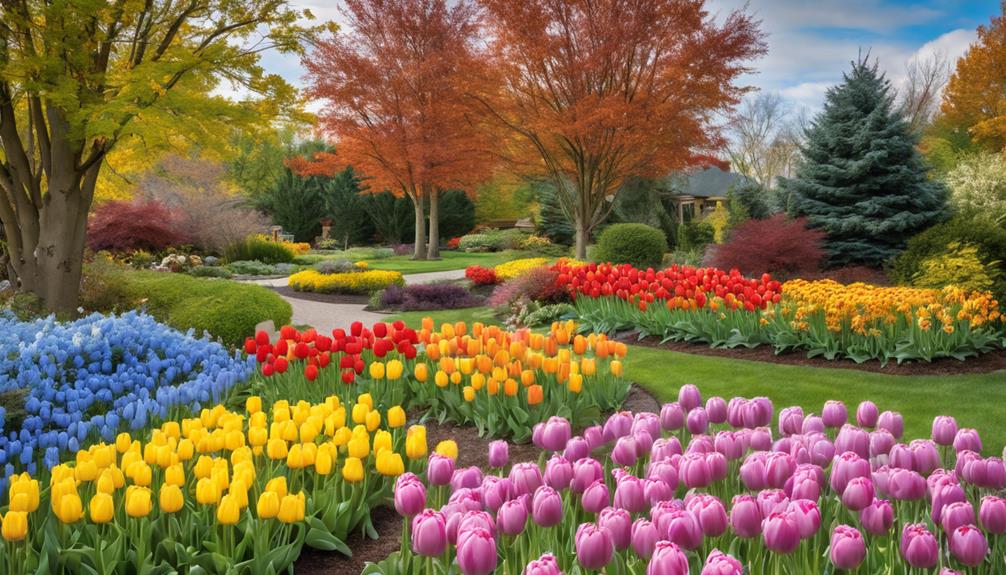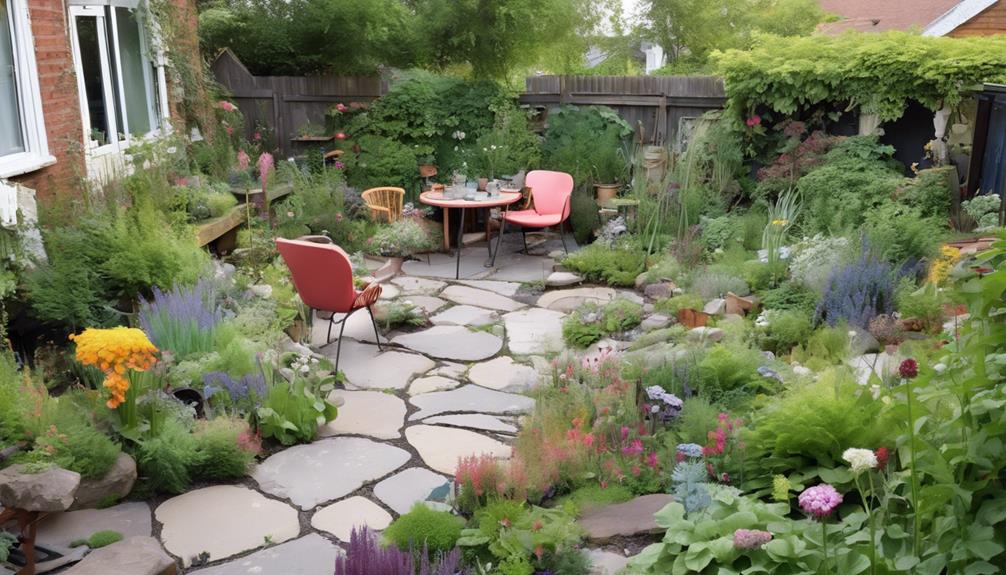
Why You Need a Seasonal Garden Cleanup Checklist?
15 March 2025
What Are Professional Landscape Architect Services?
16 March 2025To create a modern garden design, consider incorporating geometric hardscape features, such as patios and retaining walls, to define spaces and enhance functionality.
Additionally, vertical gardens optimise limited areas while adding aesthetic appeal through climbing plants and innovative structures.
Finally, adopt sustainable practices, such as selecting native plants and implementing smart irrigation systems, to promote ecological balance and reduce maintenance requirements.
These stylish ideas not only elevate your outdoor space but also contribute to environmental stewardship.
Explore further to uncover additional tips that will enrich your garden's beauty and sustainability.
Garden Design Essentials
Effective garden design hinges on two key components: fundamental plant selection and creative hard landscaping features.
Choosing the right plants not only enhances aesthetic appeal but also ensures sustainability and adaptability to the local environment.
Meanwhile, incorporating unique hard landscaping elements can create functional spaces that complement the natural beauty of the garden.
Essential Plant Selection
Choosing the right plants is vital for creating a contemporary garden that is both visually appealing and environmentally sustainable. Focus on native species, as they require less water and maintenance while promoting local biodiversity.
Incorporate a mix of perennials and evergreens to ensure year-round visual interest and structure. Consider the plant's growth habits, such as height, spread, and seasonal changes, to create a cohesive design.
Group plants with similar water and sunlight requirements to improve health and reduce waste. Furthermore, adopt a palette that complements your entire garden theme, using colour and texture to evoke desired moods.
Innovative Hardscape Features
A variety of creative hardscape features can dramatically improve the functionality and aesthetic appeal of a modern garden. Elements such as geometric paving stones, decorative walls, and integrated seating areas not only boost visual interest but also serve practical purposes.
For instance, a well-designed patio can create an inviting focal point for outdoor gatherings, while retaining walls can effectively manage soil erosion and define spaces. Incorporating water features, like sleek fountains or reflecting pools, adds a serene ambience, promoting relaxation.
Additionally, utilising sustainable materials such as permeable pavers fosters environmental responsibility. By thoughtfully integrating these innovative hardscape elements, one can achieve a harmonious balance between form and function, ultimately elevating the overall garden experience to new heights of sophistication.
Sustainable Material Selection
Sustainable material selection plays an essential role in modern garden design, as it not only enhances the aesthetic appeal but also promotes environmental stewardship.
Incorporating native plant selection ensures that gardens flourish with minimal resource input, while vibrant seasonal blooms can provide year-round interest.
Additionally, innovative lighting techniques can highlight these features while minimising energy consumption, creating a harmonious and sustainable outdoor space.
Native Plant Selection
Emphasising native plant selection not only improves the ecological balance of a garden but also contributes to sustainable landscape practices.
By integrating native species, garden designers can foster biodiversity, reduce maintenance, and conserve water.
Here are key considerations for selecting native plants:
- Local Adaptation: Choose species that thrive in your specific climate and soil conditions.
- Wildlife Support: Opt for plants that provide crucial habitats and food sources for local fauna, including pollinators.
- Drought Resistance: Incorporate plants that are naturally drought-tolerant to minimise irrigation needs.
- Seasonal Interest: Select a variety of native plants that offer year-round visual appeal through changing foliage, structure, and texture.
These strategies enhance both the aesthetic and ecological value of modern garden designs.
Colorful Seasonal Blooms
Incorporating colourful seasonal blooms into garden designs not only enriches visual appeal but also aligns with sustainable material selection practices.
By carefully choosing plants that thrive in your local climate, you can create a vibrant garden that requires minimal resources.
Consider the following strategies:
- Select Native Varieties: Choose blooms that are indigenous to your region, promoting biodiversity and ecological balance.
- Utilise Perennials: Opt for perennial plants that return year after year, reducing the need for replanting and conserving materials.
- Embrace Companion Planting: Combine flowers with complementary species to improve growth and deter pests naturally.
- Implement Organic Practices: Use organic fertilisers and pest control methods to ensure a healthier garden ecosystem.
These approaches not only enhance aesthetics but also foster a sustainable gardening ethos.
Innovative Lighting Techniques
Effective garden design extends beyond plants and blooms; it also encompasses the strategic use of lighting to enhance the overall atmosphere and functionality of outdoor spaces.
Creative lighting techniques can transform a garden into an enchanting haven while accentuating its architectural features. To achieve this, consider the following:
- Solar-Powered Fixtures: Harness renewable energy with solar lights that charge during the day and illuminate at night.
- LED Strip Lights: Use flexible LED strips to highlight pathways or garden beds, providing a modern touch.
- Smart Lighting Systems: Integrate smart technology that allows for customisable lighting schedules and colours.
- Recycled Materials: Opt for fixtures made from recycled or upcycled materials, promoting sustainability in design.
Employing these techniques will enhance not only aesthetics but also environmental responsibility.
Design a Focal Point
Creating a focal point in your garden begins with a clear definition of its purpose, whether for relaxation, entertainment, or aesthetic appeal.
Consider the ideal planting zones to ensure that your chosen features thrive within their environment.
Furthermore, incorporating vertical garden innovations can enhance the visual interest and functionality of your space.
Define Your Garden's Purpose
A well-defined purpose is vital for any garden, as it guides the design process and enhances its overall appeal.
Establishing your garden's intent allows for a focused approach, ensuring that every element serves a specific role.
Here are four fundamental purposes to reflect on when defining your garden:
- Relaxation: Create a serene environment with seating areas and calming water features.
- Entertainment: Design spaces for outdoor gatherings, including patios and fire pits.
- Edibles: Incorporate vegetable and herb beds for a functional yet aesthetically pleasing landscape.
- Wildlife Habitat: Develop areas that attract beneficial insects and birds, thereby enhancing biodiversity.
Planting in Optimal Zones
Focal points in garden design provide a sense of structure and visual interest, guiding the eye and enhancing the overall aesthetic.
Strategically selecting and placing focal points can transform a garden space, making it not only functional but also enchanting.
Here are four stylish ideas for creating effective focal points:
- Sculptural Plants: Utilise unique, architectural plants that draw attention and add texture.
- Water Features: Incorporate a fountain or pond to introduce movement and sound, enriching the sensory experience.
- Statement Furniture: Choose bold outdoor furniture that invites relaxation and conversation, while serving as a visual anchor.
- Art Installations: Integrate sculptures or art pieces that resonate with your personal style, creating a distinctive character within the garden.
Vertical Garden Innovations
Incorporating vertical garden innovations can significantly enhance the aesthetic appeal of a space while maximising limited areas.
These creative designs serve not only as eye-catching focal points but also elevate the entire environment.
Below are four key elements to consider when designing a vertical garden:
- Modular Systems: Utilise customizable panels that allow for diverse plant arrangements and easy maintenance.
- Irrigation Solutions: Implement integrated watering systems to ensure consistent hydration, promoting healthy growth.
- Lighting Features: Incorporate LED grow lights to improve plant visibility and extend growing hours, particularly in shaded areas.
- Artistic Frames: Use unique frames or structures to create visual interest, transforming plants into living art.
Enhanced Property Value
Investing in modern garden design can significantly enhance property value, often yielding returns that exceed initial expenditures. A well-executed garden not only improves visual appeal but also contributes to the overall functionality of outdoor spaces, making them more attractive to potential buyers.
| Design Element | Impact on Value | Considerations |
|---|---|---|
| Native Plantings | High | Low maintenance, eco-friendly |
| Outdoor Living Areas | Moderate | Increases usable space |
| Hardscaping | High | Durable, aesthetic appeal |
These strategic improvements can transform a property into a desirable haven, ensuring that it stands out in a competitive market. Ultimately, a modern garden design not only enhances visual aesthetics but serves as a tangible investment in the property's future.
Smart Irrigation System Installation
The implementation of smart irrigation systems is essential for modern garden design, contributing to water conservation and efficient resource management.
Key components such as rainwater harvesting systems, drip irrigation systems, and soil moisture monitoring systems optimise water usage while promoting plant health.
Rainwater Harvesting Systems
Rainwater harvesting systems are increasingly becoming a crucial component in modern garden design, as they efficiently capture and utilise natural precipitation for irrigation purposes.
By integrating these systems, gardeners can greatly reduce reliance on municipal water supplies while promoting sustainability.
Key considerations for effective rainwater harvesting include:
- Collection Systems: Install gutters and downpipes to channel rainwater into storage tanks.
- Storage Solutions: Use above-ground or underground cisterns to store harvested water, ensuring proper sealing to prevent contamination.
- Filtration Methods: Implement filters to remove debris and particulates, maintaining water quality for irrigation.
- Distribution Networks: Design a smart distribution system that connects to existing irrigation setups, optimising water usage.
Embracing rainwater harvesting can improve both the ecological footprint and aesthetic value of modern gardens.
Drip Irrigation Systems
Integrating advanced irrigation techniques, such as drip irrigation systems, enhances the efficiency of water usage in modern garden design.
Drip irrigation delivers water directly to plant roots, minimising evaporation and runoff. This system not only conserves water but also promotes healthier plants by providing consistent moisture levels.
Here are four key benefits to consider when implementing drip irrigation:
- Precision Watering: Targeted delivery ensures that each plant receives the necessary moisture.
- Reduced Weeds: Watering specific areas minimises excess moisture, discouraging weed growth.
- Water Conservation: Reduces overall water usage compared to traditional methods.
- Flexible Installation: Adaptable for various garden layouts and plant types, making it ideal for diverse landscapes.
Adopting drip irrigation systems is a hallmark of sophisticated garden design.
Soil Moisture Monitoring Systems
Effective garden management increasingly relies on soil moisture monitoring systems, which provide crucial data for refining irrigation practices.
By integrating these advanced systems, gardeners can markedly improve water efficiency and plant health.
Key components of a successful installation include:
- Soil Sensors: These devices measure moisture levels at different depths, allowing for precise irrigation scheduling.
- Data Analytics: Advanced algorithms analyse moisture data and weather forecasts to predict irrigation needs.
- Automated Controls: Smart irrigation controllers adjust watering schedules based on real-time soil conditions.
- Mobile Connectivity: Many systems offer apps for remote monitoring and management, ensuring ideal care for your garden.
With these tools, gardeners can achieve a sustainable and thriving landscape, fostering both beauty and ecological responsibility.
Maintenance and Pest Control
Effective maintenance and pest control are crucial components of contemporary garden design.
By selecting pest-resistant plant varieties and employing targeted pest management techniques, gardeners can minimise the impact of pests while promoting a healthy ecosystem.
This approach not only enhances the resilience of the garden but also reduces the necessity for chemical interventions.
Pest-Resistant Plant Varieties
Selecting pest-resistant plant varieties is a crucial strategy for maintaining a healthy garden with minimal intervention.
These plants not only thrive in diverse environments but also deter pests naturally, reducing the need for chemical treatments.
By incorporating pest-resistant varieties, gardeners can promote biodiversity and establish a resilient ecosystem.
Consider the following options:
- Lavender – Known for its aromatic oils, it repels pests such as moths and mosquitoes.
- Marigolds – Their vibrant blooms deter nematodes and other harmful insects.
- Sage – This herb not only enhances culinary dishes but also wards off cabbage moths.
- Echinacea (Coneflower) – Attracts beneficial pollinators while resisting many common pests.
Embracing these selections fosters a sustainable garden environment.
Pest Management Techniques
In any thriving garden, maintaining a proactive approach to pest management is essential for preserving plant health and ensuring a fruitful yield.
Employing effective techniques can mitigate pest issues while fostering a sustainable ecosystem. Consider the following strategies:
- Regular Monitoring: Conduct frequent inspections of your plants to identify early signs of pest activity.
- Cultural Practices: Implement crop rotation and companion planting to disrupt pest lifecycles and promote beneficial insects.
- Natural Predators: Introduce or encourage beneficial insects, such as ladybirds and lacewings, that prey on common pests.
- Organic Treatments: Utilise eco-friendly pesticides or homemade solutions, like neem oil, to manage infestations while minimising harm to the environment.
Adopting these techniques will fortify your garden against pest challenges and improve its overall health.
Pest-Resistant Plant Selection
A strategic approach to pest-resistant plant selection can considerably enhance the resilience of a garden while reducing reliance on chemical interventions.
Choosing the right plants not only improves aesthetic appeal but also promotes ecological balance. Here are four crucial criteria for selecting pest-resistant plants:
- Native Species: Opt for plants native to your region, as they are naturally adapted to local pests and diseases.
- Companion Plants: Incorporate species that deter pests or attract beneficial insects, thereby improving garden health.
- Diversity: Cultivate a diverse plant palette to disrupt pest life cycles and reduce outbreaks.
- Disease Resistance: Select varieties known for their resistance to common diseases, ensuring longevity and vigour.
Implementing these principles establishes a thriving, sustainable garden ecosystem.
Why Choose TKL Birmingham Gardener
Choosing TKL Birmingham Gardener offers a unique blend of expertise and personalised service that sets it apart in the competitive landscape of garden design and maintenance.
With a team of highly skilled professionals, TKL Birmingham Gardener employs cutting-edge techniques and sustainable practices to enhance your outdoor space. Their all-encompassing approach includes meticulous planning, execution, and ongoing care, ensuring that each garden reflects the client's vision while thriving in its environment.
Furthermore, TKL emphasises collaboration, engaging clients throughout the design process to achieve a harmonious balance between aesthetics and functionality.
Their commitment to quality and attention to detail guarantees results that not only meet but exceed expectations.
For those seeking mastery in garden design, TKL Birmingham Gardener is an unparalleled choice, ensuring lasting beauty and value.
Common Garden Design Questions
Garden design can evoke a myriad of questions, especially for those embarking on the transformation of their outdoor spaces. Common enquiries often revolve around selecting the right plants, ideal layout design, and understanding soil conditions.
Mastery in garden design requires knowledge of plant compatibility, ensuring that chosen species thrive harmoniously. In addition, one must consider the scale and proportion of elements within the space, creating a cohesive environment.
Questions regarding seasonal maintenance and sustainability are also critical, as they influence long-term success. Aspiring designers should investigate cutting-edge techniques, such as layering and focal points, to enhance visual interest.
Incorporate Edible Landscaping Ideas
While transforming an outdoor space into a vibrant landscape, incorporating edible plants can enhance both aesthetics and functionality.
This creative approach not only beautifies your garden but also provides fresh produce at your fingertips.
To master the art of edible landscaping, consider these four ideas:
- Herb Spiral: Create a vertical garden with a spiral design, maximising space while allowing for a variety of herbs to flourish.
- Fruit Trees as Focal Points: Position small fruit trees strategically to serve as eye-catching features that also yield delicious harvests.
- Vegetable Borders: Use colourful vegetable varieties as borders, blending them seamlessly with ornamental plants.
- Edible Ground Cover: Choose low-growing edible plants like strawberries or creeping thyme to create vibrant ground cover that enhances visual appeal.




